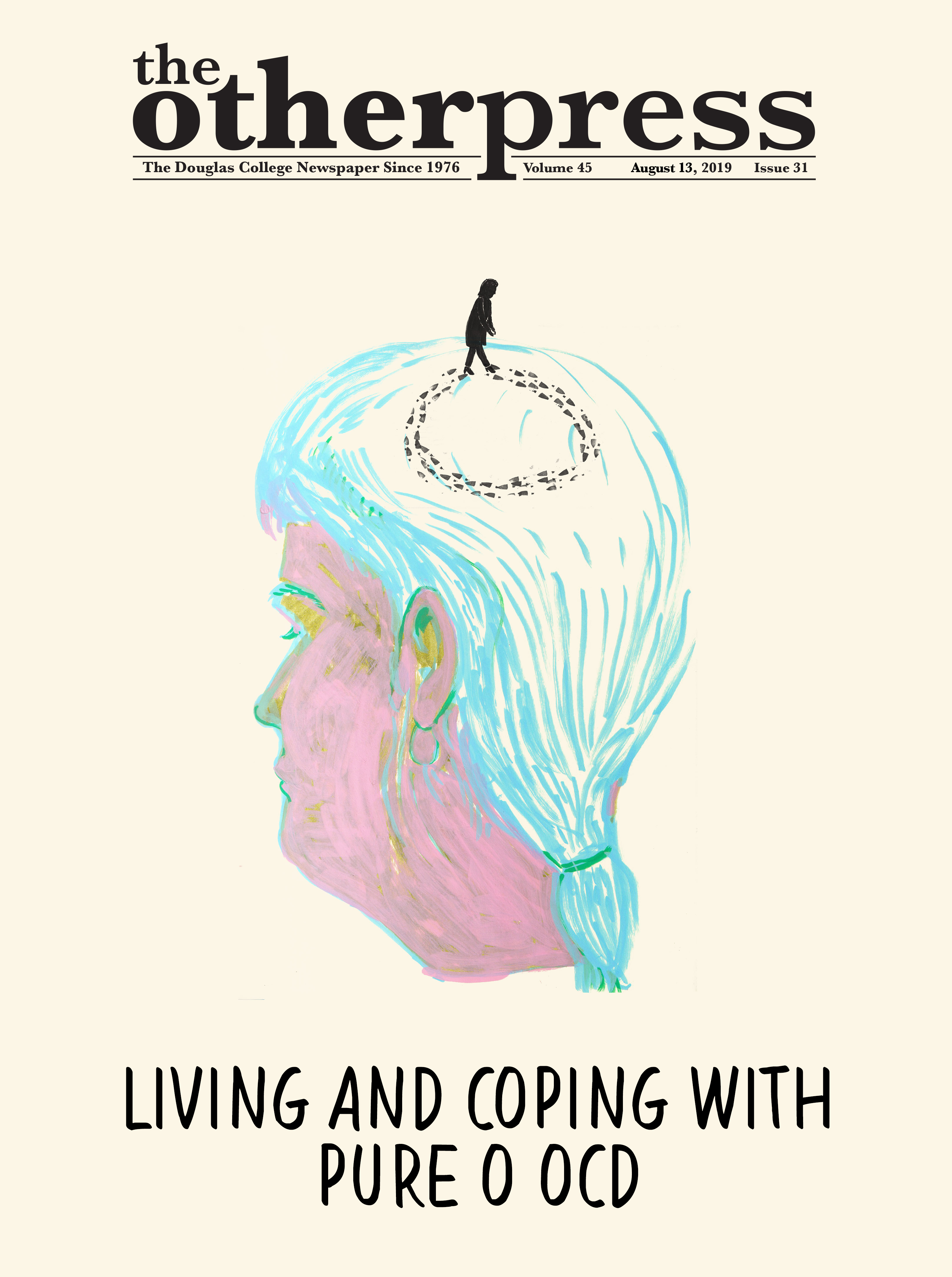
Living and coping with Pure O
By Hayleigh Fleming, Contributor
I remember sitting in the comfy pink chair in my therapist’s office, filled with optimism. It finally made sense to me and I was now able to get help without fear. I wondered what type of treatment we would do, how she would help me. I was at last on the road to peace.
“I think I have Pure O,” I said confidently. She looked at me with a puzzled expression.
“I have Pure O. You know what that is, right?” I started to feel nervous as I watched her mouth slide into an uncomfortable line.
“No, I’m not familiar with that. Can you explain it to me?” she finally responded; and in that moment, I had never felt more helpless.
Unfortunately, this is the reality for many of those who make the decision to ask for help. Pure O OCD is a condition that is only just recently coming to light, and sadly, in addition to the general public, many mental health professionals are still in the dark about what this condition is. It is so unheard of that most people are not even aware that they have it; in fact, I found out not through conversations with medical professionals but through my own online research. I deeply connected with all of the literature and felt like it was written about me. Eventually, I stumbled across an entire community of people that were experiencing the exact same thing.
What is Pure O?
Pure O, or Pure Obsessional, falls under the umbrella of Obsessive-Compulsive Disorders (OCD). Unlike what’s commonly thought of as typical OCD, which usually entails both internal obsessions and external compulsions and rituals, Pure O exhibits itself through repetitive, unwanted intrusive thoughts that are usually disturbing in nature. These intrusive thoughts can be extremely alarming and debilitating, causing significant distress to those who experience them. People who live with Pure O find it extremely difficult to reach out due to the nature of the thoughts. They fear judgement, ridicule, or even punishment. Similar to stereotypical OCD behaviours, individuals with Pure O do engage in compulsions—rituals to reduce or minimize stress—though they are subtle and mostly hidden. These behaviours often include seeking constant reassurance, obsessive online researching, and avoidance.
Intrusive thoughts
Everyone has experienced an intrusive thought at one point or another. You know, those bizarre “What if I crash my car into that pole?” type moments. Typically, those thoughts pass as quickly as they come. However, for someone experiencing Pure O, these thoughts tend to get “stuck.” Instead of letting the thought simply be a thought, the individual immediately judges the thought as “bad” and will question why they had the thought in the first place. They will assume that the thought must be representative of their character or reflect an inner desire.
For example, following the thought about crashing their car into a pole, the person then decides, “This must mean I want to hurt myself or others.” This thought directly contradicts this person’s morals and values, and as a result they begin to question those aspects of their self. “Does this mean I am a dangerous person?” This questioning of one’s inner character then results in an obsessive process of searching for evidence that makes that statement true. For example, they might think, “Well, one time I was so angry at my sister I wanted to push her,” which then reinforces the idea that they are in fact a dangerous person.
To minimize stress and avoid an encounter like this again, this person may avoid driving at all out of fear that they will have another intrusive thought or badly hurt themselves or others. Additionally, this person may even escalate to avoiding loved ones or people altogether based on the belief that they truly are a dangerous person.
While intrusive thoughts look different for everybody, there are a few categories of intrusive thoughts, widely referred to as “themes,” that people with Pure O commonly experience:
- Harm OCD: Fear of harming yourself or others.
- Sexuality OCD: Fear of changing sexual identities (a straight person being attracted to the same sex, a gay person being attracted to the opposite sex), fear of being addicted to sexual activities, or fear of engaging in inappropriate sexual behaviours.
- Relationship OCD: Fear of being inadequate for one’s partner, not loving enough, or not with the “right” person.
- Religious OCD: Fear of doubting one’s faith, fear of participating in religious activities that go against one’s one faith (satanism, worshiping the devil), fear of being sexually attracted to religious figures, or fear of going to hell.
Not a one-size-fits-all disorder
During the peak of my Pure O, I was plagued by harm OCD. I can recall lying down with my partner when I had a sudden intrusive thought about hitting him. I immediately spiraled into a panic attack. Since I also lived with panic disorder, the initial panic attack triggered several others that followed. I became so terrified of myself that I actually asked him to leave. I was scared to be around him out of fear that I was suddenly turning into a violent person who needed to be locked away from society forever. I ended up refusing to let him come over for three more days. Finally, when I saw him again, I made him sit across the room from me. I had to gradually decrease the proximity between us, until eventually I was able to sit beside him without having a panic attack.
I experienced Pure O, without being aware of it, for nearly five years before I found out what was truly going on. Even though I finally understood what was happening, it was still so difficult to talk about. I started with the people I trusted the most, my mom and my partner. Thankfully, they were both extremely understanding and supportive. They gave me the confidence to take it a step further and reach out to a professional.
Even though I had to explain to my therapist what Pure O was, she realized very quickly what was going and knew how to help. I now see my therapist regularly. We practice a blend of cognitive behavioural therapy and exposure therapy. I have a self-care routine that includes a lot of mindfulness, and a strong support network to help me when it gets rough. Although this is something I will live with for the rest of my life, I now have the tools to cope. My thoughts no longer rule me, and most of the time I can let them be what they are—thoughts.
This is my story. However, there are thousands of people out there with their own experiences and challenges. Pure O is not the same for everybody. Each experience is unique in its own way, and everyone is affected by it differently. If you find yourself feeling alone, please remember that you are not. There is an entire community of people who navigate Pure O on a daily basis. Here are some of their stories, collected from people in my Pure O support group.
“Intrusive thoughts look completely different from the perception I have of myself. It feels like my strongest values and beliefs are put to the test. I struggle with sexuality OCD. IT’s hard because I’ve always identified as a straight person. The most difficult part has been that I’ve stayed away from people I love because being around them would trigger the thoughts. I still have intrusive thoughts, but behavioural therapy and medication have been life changing. Even though I still struggle with it every day, it’s been less hard to fight back.” – Muhammed, 18.
“When I first started to have intrusive thoughts, I had no idea what was wrong with me. I experience thoughts of seeing someone naked or violently hurting someone. I was taught that thoughts precede actions, and that terrified me. I would try to resist the thoughts which would make them worse. I felt guilt and shame. It always ended in a panic attack. I was scared to get help. I feared I might go to jail, or I’d lose the people I love. I finally spoke to my bishop at church about what was going on, and he recognized my OCD right away. Now I am on a waiting list for therapy. I have researched different natural remedies and participate in activities I enjoy. Pure-O is a hidden disease, and anyone can have it. I have learned that every thought is a choice. I can feed into them with my compulsions and find temporary relief, or accept the thought for what it is, and move on.” – Jessica, 45.
“I experience intrusive thoughts and get imaginary sexual feelings about the devil. I don’t believe in the devil, but my OCD always tries to tell me I have some weird fetish. I’m so afraid of feeling arousal that my brain creates those feelings. Exposure therapy has helped me significantly, I have learned to ‘ride the wave’ of my thoughts instead of resisting them. I want people to know that OCD is not always just germs and cleaning. It can be so much more.” – Mel, 27.
You are not your thoughts
Pure O is a complex and challenging disorder. It confuses identity with imagination and can leave one feeling lost, scared, and confused. It is important to remember that thoughts are not fact, nor are they representative of one’s character. They have no motive or inner desire. They are just thoughts.
While Pure O can feel debilitating and permanent, it is very treatable and requires disrupting the cycle of rumination. If you suspect you may have Pure O OCD, start by reaching out to someone you trust. If you feel comfortable reaching out professionally, it may be helpful to find a therapist who specializes in OCD. Cognitive behavioural therapy and exposure therapy are the two most common forms of treatment for Pure O OCD, though there are also many other therapies and techniques that are available to explore. If you are considering medication, make sure to consult a medical professional for options and guidance.
Most importantly, remember: You are not alone.


